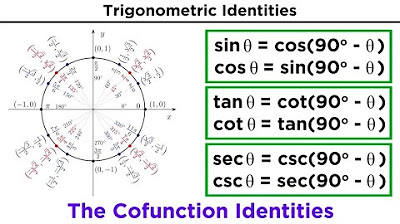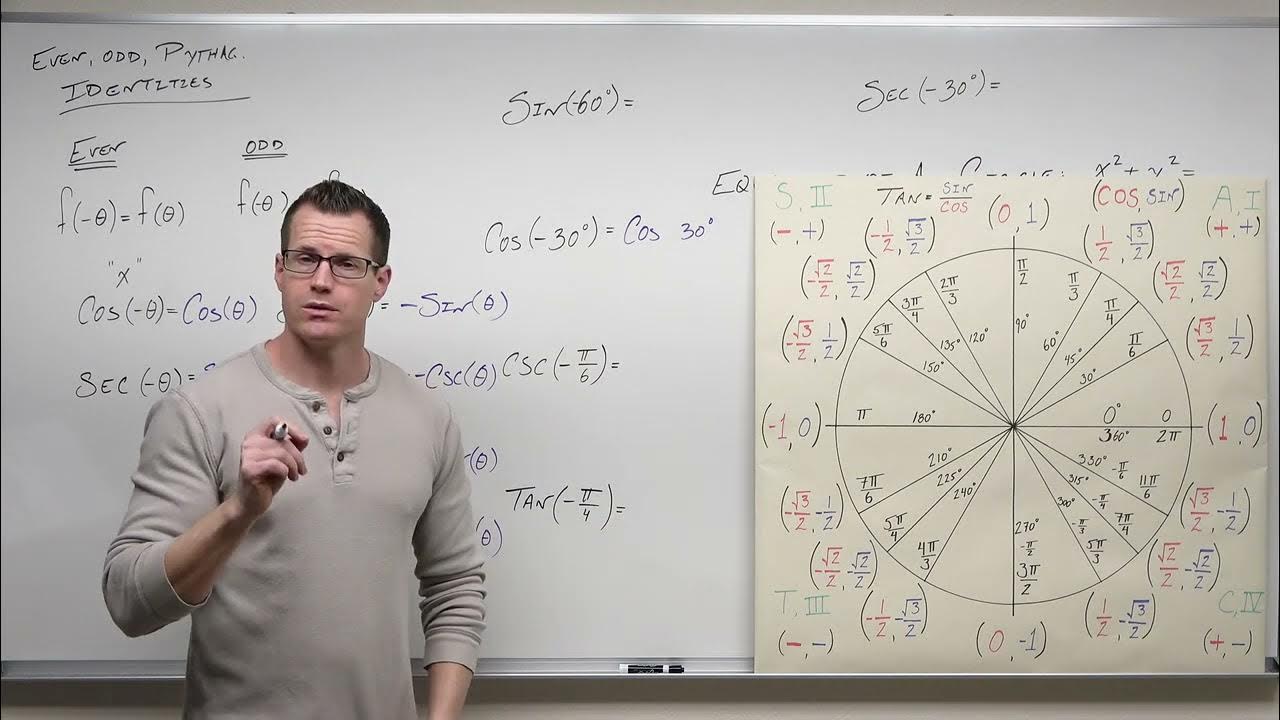Intro to Trigonometric Identities - part 1
TLDRThis video serves as an introductory guide to trigonometric identities, explaining the concept and its distinction from algebraic equations. It delves into common trig identities, such as sine squared plus cosine squared equals one, and demonstrates their proofs using the unit circle method. The script also tackles problem-solving techniques in trigonometry, showcasing how to simplify and prove given identities. The video aims to equip viewers with a foundational understanding of trigonometric identities and their applications in mathematical proofs.
Takeaways
- 😀 Trigonometric identities are mathematical expressions that hold true for all values of their variables, similar to algebraic identities.
- 🔍 An identity is distinguished from an equation by its universal truth, whereas an equation has specific solutions.
- 🚫 Identities often have conditions, such as not dividing by zero, which must be considered to ensure their validity.
- 📚 Common trigonometric identities include \( \tan(\theta) = \frac{\sin(\theta)}{\cos(\theta)} \) and \( \sin^2(\theta) + \cos^2(\theta) = 1 \).
- 📐 The unit circle method is used to prove trigonometric identities, demonstrating the relationship between sine, cosine, and the angle.
- 📉 The identity \( \sin^2(\theta) + \cos^2(\theta) = 1 \) is proven using the unit circle, where the radius is 1 and the equation of the circle is \( x^2 + y^2 = 1 \).
- 🔢 Trigonometric identity problems often involve proving an identity by simplifying one side to match the other, using known identities and algebraic techniques.
- 📚 Algebraic identities, such as the difference of squares, can be used to simplify trigonometric expressions and prove identities.
- 🔄 The process of proving an identity involves starting with the more complex side and simplifying it to match the simpler side, often using algebraic manipulation.
- 📚 Examples given in the script include proving \( \frac{\cos^4(\theta) + \sin^4(\theta)}{\cos^2(\theta)} = 1 + \tan^2(\theta) \) and \( (\sin(\theta) + \cos(\theta))^2 = 1 + 2\sin(\theta)\cos(\theta) \).
- 📚 Trigonometric identities can involve more than just sine, cosine, and tangent; they can also include other trigonometric functions.
Q & A
What is the main topic of the video?
-The main topic of the video is an introduction to trigonometric identities, including what they are, some examples, and how to solve problems involving them.
What is the difference between an algebraic identity and an equation?
-An algebraic identity is a statement that is true for all values of the variables involved, such as (a + b) squared. An equation, on the other hand, has specific solutions that satisfy the equality, like (x^2 = 9) which has solutions (x = -3) and (x = 3).
What is an identity in the context of trigonometry?
-In trigonometry, an identity is a mathematical statement that holds true for all values of the variable within certain conditions, such as (tan(θ) = sin(θ) / cos(θ)).
Why might a trigonometric identity be undefined?
-A trigonometric identity might be undefined when the value of the variable causes division by zero, such as when (cos(θ) = 0), which occurs at angles like 90 degrees, 270 degrees, etc.
What is the Pythagorean trigonometric identity?
-The Pythagorean trigonometric identity is (sin^2(θ) + cos^2(θ) = 1), which states that the sum of the squares of the sine and cosine of an angle is always equal to one.
How does the video prove the Pythagorean trigonometric identity using the unit circle?
-The video uses the unit circle to show that the x-coordinate (cosine) and y-coordinate (sine) of any point on the circle satisfy the equation (x^2 + y^2 = 1), thus proving the identity.
What is the purpose of using trigonometric identities in solving problems?
-Trigonometric identities are used to simplify expressions, prove other identities, and solve various mathematical problems involving trigonometric functions.
How does the video approach proving a more complex trigonometric identity?
-The video demonstrates the process by starting with the more complex side of the identity, applying algebraic identities to simplify the expression, and gradually transforming it to match the other side of the identity.
What is the strategy for choosing which side of an identity to start with when proving it?
-There is no hard rule, but generally, one would start with the messier or more complex side of the identity and simplify it to match the other side.
How does the video illustrate the process of simplifying an identity involving powers and squares?
-The video uses the identity (cos^4(θ) + sin^4(θ)) over (cos^2(θ)) and shows how to rewrite it as a difference of squares, simplify using the Pythagorean identity, and eventually match the right-hand side of the original problem.
What are some common mistakes students might make when working with trigonometric identities?
-Common mistakes include confusing identities with equations, not considering the conditions under which an identity holds, and not simplifying expressions correctly.
What additional resources does the video offer for further understanding of trigonometric identities?
-The video mentions that there will be more in-depth content in following videos and suggests problems in the description for practice.
Outlines
📚 Introduction to Trigonometric Identities
The first paragraph introduces the concept of trigonometric identities, distinguishing them from algebraic identities and equations. It explains that identities are true for all values of variables under certain conditions, unlike equations which have specific solutions. The paragraph also highlights the importance of understanding the difference between identities and equations, and sets the stage for exploring specific trigonometric identities in the subsequent content.
📐 Exploring Common Trigonometric Identities
This paragraph delves into common trigonometric identities, such as the tangent identity and the Pythagorean identity for sine and cosine. It uses the unit circle method to prove the Pythagorean identity, demonstrating how sine and cosine values relate to the coordinates of a point on the unit circle. The explanation also touches on the conditions under which these identities hold true, emphasizing the importance of avoiding division by zero and other undefined scenarios.
🔍 Solving Trigonometric Identity Problems
The third paragraph discusses the types of problems involving trigonometric identities, focusing on proofs. It provides an example of simplifying a complex identity using algebraic identities and trigonometric properties. The paragraph illustrates the process of starting with the more complicated side of an equation and simplifying it to match the other side, ultimately proving the identity. It also offers a second example, showcasing a simpler approach to proving an identity by expanding and combining terms to reach the desired result.
Mindmap
Keywords
💡Trigonometric Identities
💡Algebraic Identities
💡Equation
💡Unit Circle
💡Sine
💡Cosine
💡Tangent
💡Proof
💡Pythagorean Identity
💡Algebraic Manipulation
Highlights
Introduction to trigonometric identities and their importance in mathematics.
Explanation of algebraic identities and their difference from equations.
Use of the equality symbol with three lines to denote an identity.
Difference between an equation and an identity, emphasizing the universal truth of identities.
Conditions under which identities hold true, such as avoiding division by zero.
Introduction to the trigonometric identity tan(θ) = sin(θ)/cos(θ) and its exceptions.
Proof of the identity sin²(θ) + cos²(θ) = 1 using the unit circle method.
Explanation of how the unit circle helps in understanding trigonometric functions.
Demonstration of how to use algebraic identities to simplify trigonometric expressions.
Example problem: Proving the identity cos⁴(θ) + sin⁴(θ) / cos²(θ) = 1 + tan²(θ).
Technique of starting with the more complicated side of an identity to simplify.
Use of the difference of squares identity to simplify trigonometric expressions.
Simplification of the identity using the known identity sin²(θ) + cos²(θ) = 1.
Conversion of tan²(θ) into sin²(θ)/cos²(θ) to match the right-hand side of the identity.
Second example problem: Proving the identity (sin(θ) + cos(θ))² = 1 + 2sin(θ)cos(θ).
Expansion of the squared expression to simplify the identity.
Final simplification leading to the conclusion of the identity.
Invitation to try more problems and subscribe for further content on trigonometric identities.
Transcripts
Browse More Related Video

Pythagorean Identities - Examples & Practice Problems, Trigonometry

Verifying Trigonometric Identities

Identities Grade 11: Introduction and practice

Basic Trigonometric Identities: Pythagorean Identities and Cofunction Identities

5.4.1 Double-Angle Identities

Pythagorean Identities for Trigonometric Functions (Precalculus - Trigonometry 10)
5.0 / 5 (0 votes)
Thanks for rating: